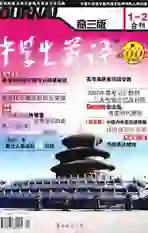高考英语单项填空题解题四法
2008-03-26王萍
王 萍
综观近几年高考单项填空题,我们不难发现这样两种趋向:1. 单项填空题合理地淡化了对纯语法和纯词法的考查,而是结合语境和语意,考查考生综合运用语言的能力;2. 单项填空题加强了对考生句法分析能力的考查加重,出现了一些长难句,一些需要同学们仔细分析句子结构的题目。因此,要做好单项填空题,同学们光靠死记硬背些单词和语法规则肯定是行不通的。笔者依据多年的高三教学实践,针对高考命题的方向,将单项填空题的解题策略归纳为以下四法:题眼法、还原法、一致法和标点法。
一、 题眼法
题眼法也即语境分析法。“眼”指的是题干中的解题关键信息,一旦抓住了它,就能掌握选择的依据。在解题时,同学们应该树立全局观和整体观,把每个单项填空题当成一个小的阅读理解题,认真分析语境,准确理解和把握信息并关注关键词句,以找出突破口。例如:
(1) —Is there fog in the evening?
—There_____be. Ill make a phone call to find it out.
A. must B. would C. will D. might
(2) Most of the Europeans refuse to accept GM food_____ Americans regard it as the fruit from high tech.
A. when B. as
C. while D. the moment
(3) Unfortunately, when I dropped in, Do-ctor Li_____ for Beijing to join in the fight against SARS, so we only had time for a few words.
A. just left B. had just left
C. is just leaving D. was just leaving
(4) In Canada, the winters are very cold and every Canadian girl and boy knows how to_____ for the weather.
A. wear B. dress
C. have on D. put on
(5) Is there any possibility of the film
in Paris International Festival?
A. being tried out B. trying out
C. tried out D. to try out
(6)_____, but he insisted that he_____ to school.
A. Though he was ill; went
B. Having been ill; went
C. Having been ill; should go
D. He was ill; go
Keys: D C D B A D
解析:上述六题题干中黑体部分均为“题眼”,(1)—(3)题的解题关键在于把握好上下文信息。(1)题从Ill make a phone call to find it out.可知,说话人对于当晚是否有雾不那么确信,因此选择might一词;(2)题黑体部分可知,大部分欧洲人排斥转基因食物,而美国人却认为转基因食物是高科技的成果,前后句明显存在转折关系,因而选择连词while;(3)题从so we only had time for a few words可知,说话人和李博士还是能说上几句话的,因此推断当时李博士是正要出发去北京而不是已离开。(4)—(6)题的解题关键在于抓住题干中的关键词。(4)题从how可知,不定式动词要选择不及物动词,A、C、D三项均为及物动词;(5)题考查介词of后的宾语,故选择动词-ing形式,此外,电影是被试映,因而应选择A项;(6)题由并列连词but可知,第一空要填入一个完整的并列句,由此可得出D项。
二、 还原法
还原法,也即句子结构分析法。很多高考单项填空题考点实则为难度较小的简单句,但命题人往往通过加长句式、将陈述句改为疑问句或感叹句等句型、使用插入语、采用倒装句和省略句等手段使简单的句式复杂化,以增加干扰因素。解题时,同学们应通过句型分析弄清题干的来龙去脉,还原简单句的本来面目。
主要有如下八种还原方式:
1. 将疑问句还原成陈述句。例如:
Whom is it up to_____ the matter?
A. decide B. to decide
C. deciding D. decided
解析: 将题干还原为陈述句可得出:It is up to sb. to decide the matter. 因此答案为B。
2. 将感叹句还原成陈述句。例如:
role she played in the film! No wonder she has won an Oscar.
A. How interesting
B. How an interesting
C. What interesting
D. What an interesting
解析: 将题干还原为陈述句可得出: She played an interesting role in the film.因此答案为 D。
3. 将被动语态还原成主动语态。例如:
Our time should be made full use of_____.
A. study B. studied
C. studying D. to study
解析:将题干还原成主动语态可得出:We should make full use of our time to study.因此答案为D。
4. 将倒装语序还原成正常语序。例如:
Here is a notebook, in which_____ the names of the visitors.
A. write B. written
C. were written D. was written
解析:将定语从句还原成正常语序可得出:the names of the visitors were written in the notebook,因此答案为 C。
5. 将强调句式还原成一般句式。例如:
It was_____ that resulted in the terrible car accident.
A. because of her carelessness
B. her being careless
C. because she was careless
D. she was so careless
解析: 将题干还原成一般句式可得出:Her being careless resulted in the terrible car accident.因此答案为B。
6. 将先行词还原到定语从句中。例如:
(1) The managers discussed the plan that they would like to see_____ the next year.
A. carried out B. carrying out
C. carry out D. to carry out
(2) The study you have been making_____
the ancient Chinese characters is an instructive job.
A. to B. for C. of D. from
解析: (1)把定语从句先行词plan还原回从句中得出:They would like to see the plan carried out the next year. 因而答案为A;(2)把定语从句先行词the study还原回从句中得出:You have been making the study of the ancient Chinese characters. 因此答案为C。
7. 删除附加结构,将复杂句还原成简单句。例如:
(1) John plays football_____, if not better than, David.
A. as well B. as well as
C. so well D. so well as
(2) My demand is that the information referred to in my report_____ to Mr. Brown without delay.
A. to be e-mailed B. e-mailed
C. be e-mailed D. being e-mailed
解析:(1)将插入语if not better than删除可得出:John plays football as well as David.故答案为B;(2)将后置定语referred to in my report删除可得出:My demand is that the information (should) be e-mailed to Mr. Brown without delay. 因此答案为C。
8. 将省略句还原成完整的句子。例如:
(1) I have been studying the science of outer space for the last ten years and now I still_____.
A. am B. do C. be D. have
(2) —Do you know what Tom does all day?
—I know he spends at least as much time watching TV as he_____ his lessons.
A. is doing B. does
C. spends in D. does doing
解析: (1)将题干中and后的并列句还原为完整的句子,得出: ... now I am still studying the science of outer space. 因此答案为A;(2)将连词as后的从句还原完整,得出: ... as he spends (in) doing his lessons, 此句中spends 可用does来替代,因此答案为D。
三、 一致法
一致法是另一种句子结构分析法,即在解题时,我们要注意句子前后的关系要一致,包括主谓一致、时态一致、代词一致、比较对象一致、句子结构一致等等,以此找到解题的突破口。例如:
(1) The young man rushed out of the room,_____ into his car and started it hurriedly,_____to get home as soon as possible.
A. got; hoped B. getting; and hoped
C. got; hoping D. getting; hoped
(2) Written in a hurry,_____.
A. Peter made many mistakes in the
paper
B. there are many mistakes in the paper
C. we found some mistakes in the paper
D. the paper is full of mistakes
(3) Thinking about the fact that I was not prepared well enough, and_____ to lose my face, I gave up this years civil service exam.
A. didnt want B. not wanted
C. not wanting D. not to want
Keys: C D C
解析: (1) 从and可知,此题考查三个谓语动词rushed, got和started的并列,时态要一致,所以第一空要填got,而第二空hoping是伴随状语;(2)分词短语作状语时,其逻辑主语必须与主句主语保持一致。此题中,written in a hurry的逻辑主语应该是paper,所以选择主语一致的D项;(3)此题考查and连接的两个并列状语,前后形式要一致, 故选择not wanting, 与前面thinking一致。
四、 标点法
在解答单项填空题时,标点符号的作用也不可忽视。在做题时,一个标点符号可能就决定了一个题的答案。例如:
(1) Our first destination was Indian Creek in Kansas._____ was then the frontier.
A. That B. Which C. What D. When
(2) Everyone was on time for the meeting—_____Chris, whos usually ten minutes late for everything.
A. but B. only C. even D. yet
(3) The speech_____, a lively discussion started.
A. being delivered
B. was delivered_____
C. be delivered
D. having been delivered
Keys: A C D
解析: (1)从前后句间的句号可知,后半句是独立的句子而非从句,因此不可以在句首选用从属连词,故答案为A,代词that作为句子的主语;(2)从破折号可知,符号后面的内容是对前面句子的补充说明,本句意为:每个人都准时参加了会议,甚至连Chris这个通常什么事都迟到十分钟的人都准时到了;(3)此句主干是a lively discussion sta-rted,由逗号可知,前半部分是主格独立结构作为状语,而不可能是完整的句子。此外,根据句意,应该是发表演讲在前,然后才是讨论,故选择分词的完成式。
